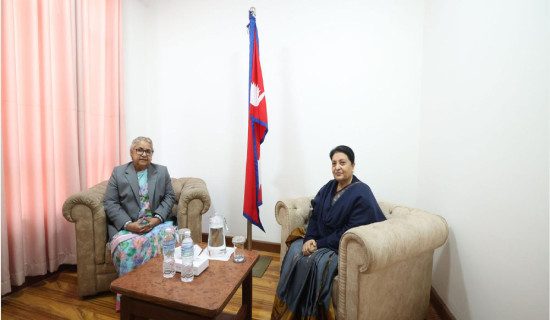- Sunday, 7 December 2025
Harness Full Potential Of Tourism
The tourism sector is the second largest foreign exchange spinner of Nepal after the remittance sector. For a poor country like Nepal, the contribution of the tourism sector to the economy can hardly be overstated. However, the tourism sector took a beating from the Maoist insurgency (1996-2006) and the 2015 earthquake. Moreover, in 2020 when the country launched the Visit Nepal Year 2020, the COVID-19 pandemic showed its presence in the country, forcing the government to revoke the campaign. After the revocation of the campaign, the government mulled over launching a tourism decade campaign. But unfortunately, the disease is still around us.
With the emergence of the COVID-19 pandemic, the tourism sector has not been able to fully recover. However, there are rays of hope in the tourism sector that tourist arrivals are gradually increasing in the country. According to the data published by the Nepal Tourism Board (NTB), 99,426 international tourists visited the country in March. This figure is encouraging given that the number of international tourists visiting the country in the corresponding months of 2022, 2021 and 2020 was 42,006, 15,254 and 42,776, respectively. With this encouraging growth figure, further growth is expected in April and May. These months are suitable for trekking and expedition activities.
Scope
However, the tourism sector is yet to attain the pre-COVID-19 figure. In March 2019, 127,351 tourists visited the country. In 2022, the country welcomed over 600,000 foreign tourists vis-à-vis around 1.2 million in 2019. The country is a tourist’s paradise. There are umpteen natural, social and cultural attractions. The scope of tourism is varied. Business tourism, medical tourism and nature tourism or ecotourism are some of the types of tourism. Most tourists visit the country for trekking and mountaineering purposes. It is a matter of dismay that the country has not been able to fully take advantage of the potential of tourism. The potential of tourism is high in the country. The country is blessed with unique natural features such as mountains, rivers, lakes, rich biodiversity and natural heritages.
In the late 1960s, the country was an attraction for the hippies. The hippy culture is gone now. Most of the foreign tourists visiting the country are budget tourists. The average tourist spending per day is less than 45 US dollars. The government, tourism entrepreneurs and other stakeholders should take the initiative in wooing higher-end tourists. Despite having high potential for tourism development, the return from the sector leaves much to be desired. The target of attracting just two million foreign tourists is too low. Even this figure has not been achieved. So there must be some shortcomings in the tourism sector, which need to be rectified.
While talking about such shortcomings, the development of infrastructure comes to the fore. There is no proper development of tourism infrastructure. There are many attractive places that could fascinate both domestic and foreign tourists. But access to such places is difficult owing to badly dilapidated roads. When it rains, the roads become muddy; in the non-rainy season, the roads become dusty. With damaged sections of the roads, driving through them is really an ordeal. Moreover, the vehicles may also be damaged. The road to Nagarkot, a tourists’ attraction, is a case in point. The construction of the road has been going on for over ten years. Despite constant follow-ups with the contractor, the road has remained in disrepair. It seems that contractor is more powerful than the government.
Investment also matters when it comes to developing the tourism sector. Investments from the public and private sectors are not adequate. Many people in the local community do not possess enough capacity for investment. They have difficulty with foreign languages. And they do not have technical knowledge of operating tourist-friendly hotels. However, homestays have been flourishing in some parts of the country. As the tourism sector can be considered one of the mainstays of the economy, the government, tourism entrepreneurs and other stakeholders should take concrete steps to develop and expand the tourism sector.
Strategy
They should adopt various strategies designed to give a shot-in-the-arm to the tourism sector such as product diversification and exploration of new tourist sites. The country is offering the same packages to tourists every year. New attractions such as canopy walks in the national parks, sky walks, Disneyland-like amusement parks, big zoos and attractive museums should be developed. The proposed zoo at Surya Binayak has been in limbo for years. There are religious, historical and cultural sites scattered all over the country.
By developing road networks, such sites can be made accessible to tourists. When such sites located in the rural and remote areas are developed, the hospitality industry can be promoted, creating job opportunities at the local level. It may be noted that not only foreign tourists but also domestic tourists will throng such places when they become easy for access. This will also give relief to the tourism entrepreneurs who have been claiming that they are facing difficult times owing to the sluggish trend seen in the tourism sector. They say that they are not even able to repay loan installments. It is high time the government paid adequate attention to reviving and boosting the tourism sector without delay.
(Maharjan has been regularly writing on contemporary issues for this daily since 2000.)
















